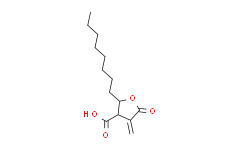| Cas No.: | 218137-86-1 |
| Chemical Name: | 3-Furancarboxylic acid,tetrahydro-4-methylene-2-octyl-5-oxo- |
| Synonyms: | 3-Furancarboxylic acid,tetrahydro-4-methylene-2-octyl-5-oxo-;3-CARBOXY-4-OCTYL-2-METHYLENEBUTYROLACTONE;C 75 (4-METHYLENE-2-OCTYL-5-OXO-TETRAHYDRO-FURAN-3-CARBOXYLIC ACID);4-Methylene-2-octyl-5-oxotetrahydrofuran-3-carboxylic acid;4-Methylene-2-octyl-5-oxo-tetrahydro-furan-3-carboxylic acid;C 75;C-75 |
| SMILES: | C=C1C(=O)OC(CCCCCCCC)C1C(O)=O |
| Formula: | C14H22O4 |
| M.Wt: | 254.322084903717 |
| Purity: | >98% |
| Sotrage: | 2 years -20°C Powder, 2 weeks 4°C in DMSO, 6 months -80°C in DMSO |
| Description: | C75 is a synthetic fatty-acid synthase (FASN) inhibitor; inhibits prostate cancer cells PC3 with an IC50 of 35 μM. |
| Target: | IC50: 35 μM (PC3 cell)[1] |
| In Vivo: | C75 blocks fasting-induced c-Fos expression in the arcuate nucleus (Arc), lateral hypothalamic area (LHA), and paraventricular nucleus (PVN) 10–24 h after i.p. injection. Intraperitoneal administration of C75 at 30 mg/kg body weight inhibits food intake of mice by ≥95% within 2 h after i.p. injection[3]. C75-treated DIO mice has a 50% greater weight loss, and a 32.9% increased production of energy because of fatty acid oxidation. C75 treatment of rodent adipocytes and hepatocytes and human breast cancer cells increases fatty acid oxidation and ATP levels by increasing CPT-1 activity, even in the presence of elevated concentrations of malonyl-CoA[4]. |
| In Vitro: | C75 inhibits PC3 cell growht with an IC50 of 35 μM at 24 h. C75 (10-50 μM) also reduces the growth of LNCaP spheroids in a concentration-dependent manner with an IC50 of 50 μM[1]. (-)-C75 inhibits FAS activity and has a cytotoxic effect on tumor cell lines, without affecting food consumption. (+)-C75 inhibits CPT1 and its administration produces anorexia, suggesting that central inhibition of CPT1 is essential for the anorectic effect of C75. The differential activity of C75 enantiomers may lead to the development of potential new specific drugs for cancer and obesity[2]. |
| Cell Assay: | Cells are seeded in 96-well plates and incubated for 2 days to allow exponential phase growth. Cells are then ished twice with PBS and treated with C75. After 24 or 48 h incubation, MTT is added to a final concentration of 0.5 mg/ml and cultures are incubated for 2 h. Cells are then solubilized with DMSO before measuring absorbance at 570 nm. Cell growth is also measured, using MTT assay, every 24 h up to 96 h[1]. |
| Animal Administration: | Mice: C75 is administered either by i.p. (i.p.; 30 mg/kg of body weight) or i.c.v. (10 μg in 3 μL of RPMI medium 1640) injection. One, 11.5, and 24 h after i.p. injection, cumulative food intake is measured, mice are killed, brains are sectioned, and slices are subjected to immunohistochemical staining for c-Fos. All i.p. injections are given 1 h before the start of the dark cycle. For i.c.v. injection, mice are anesthetized with metofane and given 3 μl of RPMI medium 1640 (control) or C75 in RPMI medium 1640 into the lateral ventricle with a calibrated 10-μl Hamilton syringe[3]. |
| References: | [1]. Rae C, et al. Inhibition of Fatty Acid Synthase Sensitizes Prostate Cancer Cells to Radiotherapy. [2]. Makowski K, et al. Differential pharmacologic properties of the two C75 enantiomers: (+)-C75 is a strong anorectic drug; (-)-C75 has antitumor activity. Chirality. 2013 May;25(5):281-7. [3]. Gao S, et al. Effect of the anorectic fatty acid synthase inhibitor C75 on neuronal activity in the hypothalamus and brainstem. Proc Natl Acad Sci U S A. 2003 May 13;100(10):5628-33. [4]. Thupari JN, et al. C75 increases peripheral energy utilization and fatty acid oxidation in diet-induced obesity. Proc Natl Acad Sci U S A. 2002 Jul 9;99(14):9498-502. |

 To enhance service speed and avoid tariff delays, we've opened a US warehouse. All US orders ship directly from our US facility.
To enhance service speed and avoid tariff delays, we've opened a US warehouse. All US orders ship directly from our US facility.




















